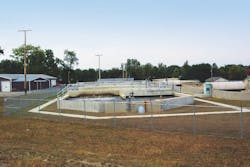About the author:
Eric Risch is marketing manager for Severn Trent Services. Risch can be reached at [email protected] or 215.997.4058.
The LaGrange, Ind., wastewater treatment facility is a 50-year-old extended air activated sludge plant designed to treat an average daily flow of 1.8 million gal per day (mgd) and an average design peak flow of 3.6 mgd. In a recent review of the plant’s performance, all indications were that the plant operation plan, which has been managed via public-private partnership by Severn Trent Services since 1997, was resulting in compliant, efficient and cost-effective operations. The staff was operating all processes as intended by the engineer’s design and fulfilling the facility’s intended purpose.
But in an era when the global green movement is focusing increased attention on conserving resources, mere compliance is not enough. In 2008, under the direction of Severn Trent, the LaGrange plant underwent a process to identify ways to reduce its carbon footprint.
Management Plan
Implementation of a sewer collection system maintenance program beginning in 1999 helped eliminate discharges from numerous combined sewer overflows and sanitary sewer overflows. This process is indicative of the successful partnership between Severn Trent and LaGrange.
Defining problems and working together to devise and implement solutions is an ongoing proactive effort. When Severn Trent made a formal, companywide commitment to monitor and reduce its carbon footprint in 2008, company personnel implemented a Site Energy Management Plan (SEMP) audit to evaluate and create action plans to improve plant energy efficiency. The ratio of kilowatt-hours used per million gallons treated is the unit of measure that evaluates a treatment plant’s carbon footprint and performance results against any set objectives.
Before Severn Trent recommends any action items resulting from a SEMP, all permit limits and client contractual requirements must be met. Unless all effluent permit and client commitments and obligations are met, no amount of kilowatt-hours reductions can be justified.
The formal SEMP performs the following actions:
• Evaluates site energy consumption by collecting an abundance of information, including a minimum of one year’s history of kilowatt-hours and plant influent flow and loading data, equipment size and horsepower, all data on chemical usage, and details on current operations to determine the optimum electric power consumption;
• Challenges current practices;
• Identifies opportunities for energy reduction; and
• Produces priority actions for increasing energy efficiency.
Energy Reduction Potential
The SEMP process model was used to evaluate the current operations of the LaGrange facility. Table 1 details the treatment facility’s base-model annual average operating characteristics.
While the process model proved the effectiveness of the LaGrange plant’s current operation, it also helped Severn Trent personnel identify six possible areas of energy reduction:
1. Discontinuing the use of the larger of two oxidation ditches (ditch No. 1, constructed during a 2002 plant upgrade) and operating the plant with the smaller ditch (ditch No. 2, out of service but capable of being rehabilitated and modified with a smaller, more efficient aerator);
2. Discontinuing the use of oxidation ditch No. 1 and operating with a refurbished but unmodified ditch No. 2;
3. Discontinuing aerobic digestion and converting digesters to nonaerated gravity settling tanks;
4. Operating the grit pump on demand instead of continuously, and continuing operation of only one of two available ultraviolet (UV) gravity flow open-channel disinfection systems as long as the use of a single UV system proves to be adequately effective;
5. Continuing to operate with one of two available UV banks and with no changes to the grit pump; and
6. Operating the grit pump on demand but with no reduction in the number of UV banks utilized.
These six strategies, determined to be the most viable methods of reducing kilowatt-hours demand at the plant, would represent estimated savings ranging from about $800 per year to more than $13,000 per year.
Method of Choice
Evaluating the feasibility of each of the approaches, officials recommended the fourth option. This approach would operate the grit pump on demand rather than continuously and use one UV bank seven months of the year to meet seasonal disinfection requirements.
The grit pumps and classifier currently are operated continuously because there is a lack of confidence in the pump priming system and the system freezes in the winter if it is not run. The issues with the priming system have to be addressed prior to operating the pump in automatic mode.
The estimated annual savings from this approach totals 59,220 kWh, a kilowatt-hours-per-million-gallons savings of 10% compared to current performance.
“The results of the SEMP audit show that plant management and staff are putting forth a strong effort to optimize operations,” said Clint Houseworth, process specialist for Severn Trent Services’ Technical Services Group. “Severn Trent is committed to continuously looking for opportunities to save energy through creative thinking that will be incorporated into long-range comprehensive planning goals. While the LaGrange plant is currently operating efficiently and effectively, creating a SEMP to guide our operating decisions will ensure even greater process and operational efficiencies in the years to come through reduced energy usage.”
Download: Here
